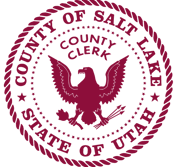Ranked Choice Voting
Ranked Choice Voting (RCV) is a type of ranked preferential voting. The Utah State Legislature made RCV possible for municipal elections in Utah with the passing of HB 35, the Municipal Alternative Voting Methods Pilot Project.
Several municipal legislative bodies (councils/mayors) in Salt Lake County have opted to hold ranked choice elections for 2025.
To practice ranked choice voting on a sample ballot, visit our Ranked Choice Voting Test Ballot.
